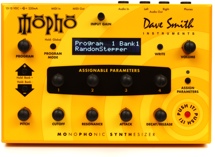
Yesterday I became the proud owner of a Dave Smith Instruments MoPho,
a monophonic analogue synthesizer that I've been juiced about since the day it
came out. The item came double packaged from Analogue Haven
and it was extremely easy and quick to set up and start messing with, as it has a little red button on
it, The
390 presets built into the box, many of which come from the DSI Prophet 08 and some inspired,
at least, by the previous Evolver series.
Every analogue sound I could possibly imagine was in
these presets, from two flavors of 303-style basses, chunky analogue kicks, sound effects, little triggered
rhythm sequences, etc. I really spent all of last night just going through the presets, which I do with any
new synth. This time is just took me a while because there is so much under the hood of this little box.
I'm really in awe of how the programmers took a two-oscillator monophonic synth and put so much stuff into it,
without even so much as a digital delay, all these sound amazing right out of the package. I haven't had an
opportunity to integrate it into my full MIDI setup or even to make a track with it, but it's really all there.
My question is: Where was this synth 20 years ago? Well, it didn't exist, and in reality, it couldn't exist, unfortunately.
Back in 1989, my father, in his wisdom, bought me a gently-used Korg M1 workstation. I was excited, after all,
I had every intention of starting on a home keyboard of some sort, although the idea of a full synthesis engine was exciting to
me, after seeing a demonstration of a Polymoog and a Prophet-5 years earlier.
I had asked him to get me a D-50, as it was hyped up as a successor to the (ugh!*)DX7 and, honestly,
it was plastered over every electronic music magazine at the time. If there was an analogue monosynth to be found,
it wasn't in the hallowed, white neon drywalls of Guitar Center or Keyboard City.
So, perhaps the M1 was the best choice for the time, after the rep had steered me away from buying
a sampler. I was into industrial music in a big way, then, and the idea of taking samples from videotapes and
making meaningful music out of that seemed exciting. Thankfully, I got a synth instead.
But, to be honest, the M1 did a lot of things that I didn't appreciate at the time, with it's 4mb of sample
memory, it produced amazing sounding, uh..., saxophones, and pan flutes. I would talk to other synth geeks at the
time, who probably were so sick of voltage controlled instruments and patch cords that the idea of being able to
play Rod Stewart covers at the roller rink seemed pretty damned exciting.
To be honest, I probably would have been well served with a Roland JX8P, a TR-505, and
a Korg DW8000. Throw in a MIDIVerb, a mixer, and some computer-based sequencer, and I
would have been in business for around, 2 grand. Wait a minute! Maybe my Dad was right, getting me an M1.
It wasn't until after I got the keyboard, though, that I learned these analogue synths, as cumbersome as they
were, had the sound that I was looking for.
After all, I was on a steady diet of Depeche Mode, Erasure, and Kraftwerk, not to mention the scores
to Blade Runner, Tron, and Beverly Hills Cop, all of which had heavy analogue synth undertones.
The Dave Smith Mopho could not have existed in 1989, as much as
I would have liked it to, as Sequential Circuits was dead in the water, after the DX7 and Dave Smith
and team were hard at work on developing the Korg Wavestation, once again, a very funky instrument, but not the
one that I was looking for, either.
I'm thankful that we have the Mopho now, and I look forward to integrating it into my productions for years to come.
No comments:
Post a Comment